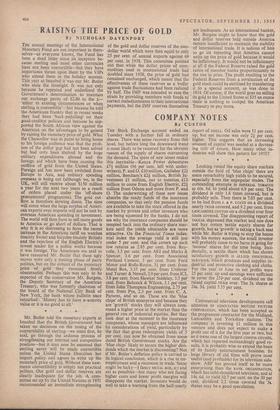COMPANY NOTES
By CUSTOS THE Stock Exchange account ended on Tuesday with a further fall in ordinary shares. There was some recovery from this level, but before long the downward trend is most likely to be resumed for the obvious reason of the supply of shares ontrunning the demand. The spate of new issues makes this inevitable—Kenya Polker debentures £71 million (96 per cent. left with under- writers), P. and 0. £10 million, Gallaher £21 million, Beecham's £21 million, British In- vestment £1 million, not to mention, £12 million to come from English Electric, £21 million from Odeon and more from P. and 0. The underwriting of these new issues absorbs the ready funds of the insurance companies, so that only the pension funds are available to take the stock offered in the market by private and other investors who are being squeezed by the banks. I do not see why the insurance companies should be tempted back into the ordinary share mar- kets until the yields obtainable are more attractive. On the Financial Times indus- trial index the average yield is still just under 5 per cent. and this covers up such low returns as 2.85 per cent. from Rey- rolle, 3.3 per cent. from AEI and Marks & , Spencer, 3.6 per cent. from Associated Portland Cement, 3 per cent. from Ford Motor and Rolls-Royce, 31 per cent. from Metal Box, 3.35 per cent. from Unilever and Turner & Newall, 3.9 per cent. from ICI, 3.8 per cent. from Hawker Siddeley, 3.5 pet cent. from Babcock & Wilcox, 3.1 per cent. from John Thompson Engineering, 2.75 per cent. from Pye, 13 per cent. from C. A. Parsons, and so on. These are the 'blue chips' of British enterprise and because they are 'growth' stocks they will always com- mand a higher price in the market than the general run of industrial equities. But they look dear at the moment to the insurance companies, whose managers are influenced by considerations of yield, particularly by the fact that gross redemption yields of 5 per cent. can now be obtained from some dated British Government stocks. Are the `blue chips' likely to secure the higher divi- dends which the market is discounting? Not if Mr. Butler's deflation policy is carried to its logical conclusion, which is a rise in un- employment and a recession in trade. Some might be lucky—I fancy METAL BOX, ICI and Am as possibles—but many who are facing higher costs and lower profit margins will disappoint the market. Investors would do well to take a warning from the half-yearly report of SHELL. Oil sales were 11 per cent. up, but net income was only 21 per cent. higher. This suggests that an increasing amount of capital was needed at a decreas- ing rate of return. How many other in- dustries will show this pattern for 1955?
•• • Looking round the equity share markets outside the field of 'blue chips' there are some remarkably high yields to be secured, especially from the unpopular trades. The outstanding example is IMPERIAL TOBACCO at 60s. 6d. to yield about 6.9 per cent. The dividend is only 1.6 times covered, but is probably safe. Then there is 7.05 per cent. to be had from J. & P. COATS on a dividend nearly twice covered, and 9.2 per cent. from LANCASHIRE COTTON on a dividend over four times covered. The disappointing report of TOOTAL depressed this market and one does not buy cotton textile equity shares for growth, but as 'growth' is taking a back seat while Mr. Butler is trying to stop the boom with his money squeeze, the small investor will probably come to no harm in going for 'income' shares for -the time being. Inci- dentally, a textile share which has shown satisfactory growth is ALLIED INDUSTRIAL SERVICES, which produces and supplies in- dustrial and protective clothing and cloths. For the year to June its net profits were 25 per cent. up and earnings were sufficient to cover the 25 per cent. dividend on the raised capital twice over. The 5s. shares at 24s. 3d. yield 5.35 per cent.
• •
Commercial television developments call attention to ASSOCIATED BRITISH PICTURE CORPORATION, which has been accepted as the programme contractor for the Midland, Lancashire and Yorkshire stations. The company is investing £1 million in this venture and does not expect to make a profit out of it for the first year or two, but as it owns one of the largest cinema circuits, which last reported outstandingly good re- sults, it is probably wise to extend the basis of its family entertainment business. Its large library of old films will prove most useful (and profitable) for its television side- show. ABP has proved itself to be more enterprising than the RANK ORGANISATION, which has cold-shouldered television, and at 14s. 6d. to yield 10.7 per cent. on the 30 per cent. dividend 2.2 times covered the 5s. shares may be a good speculation.
































 Previous page
Previous page